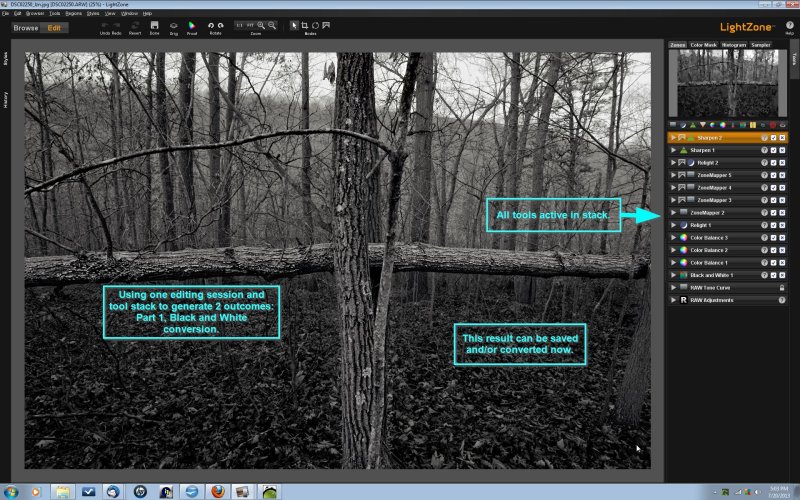
My results from printing - especially upscaling - have been breathtaking.


Black and white conversion in LightZone is superb, and of course with the Zone System analogy and tone-mapping capabilities incredibly powerful. and that it really is more intuitive than other programs. A hugely important aspect of LightZone to me is how it can be as simple or as complex as the user desires. Along with the blending modes, there is just unbelievable power behind every single tool - and very easily accessed. I love the way the tool tabs have been added to nearly all the tools. I like that selective editing in LightZone is done with regions, similar to the way dodging and burning was done in the darkroom - I think it is a more "photographic" way of working. “I currently use LightZone as my editor because it does very close to everything I need my photo editor to do.If you've ever seen stunning black and white, HDR, or high contrast photos and wondered how you could achieve the same effects in your own work, wonder no more! With LightZone, you can implement any of those styles with a single click! You can even adjust the parameters and save your work as a "Style" that can be used again and again! Whether you work with RAW, JPEG, or TIFF images, LightZone is there to make your post-shoot production go smoothly and efficiently. You can also leverage the power of LightZone to boost overall color, correct color shifts and white balance errors, selectively sharpen or blur images or parts of images, remove dust spots and reduce the noise often found in high-ISO digital images. Even better, you can adjust up to 16 exposure values, either individually or as a group. For example, you can use LightZone to adjust exposure values in your digital photos using a simple slider. LightZone lets you perform many of the most popular photo tweaks and adjustments in a snap. Thanks to LightZone, photography buffs can regain control over photo retouching and enhancement, getting things done simply, naturally, and quickly! These fibrils frequently appeared to be coiled and were of the order of magnitude ascribed to deoxyribonucleic acid molecules.Sure, the advent of computers and digital photo editing has unlocked millions of creative things to do with your pictures, but sometimes you don't want to be forced to learn editing languages or review mathematical graphs just to make a shot look the way you want it to. Another outstanding feature in many micrographs was the nucleoid, which contains dense fibrils measuring 25 to 50 A in diameter. Plasmalemmosomes have been found in both aerobically and anaerobically grown cells. The various kinds of ingrowths of the plasmalemma were designated "plasmalemmosomes" to indicate their origin however, some of these organelles in Listeria were similar to those described in different bacteria by other authors. The lamellar bodies are envisioned as resulting from spiraled ingrowths. They may branch repeatedly and anastomose to form a complicated honeycomb-like organelle or organelles of different appearances, sometimes lamellate. Intracytoplasmic membranes of various configurations were clearly shown to be extensions of the plasmalemma.

This structure corresponds to a "unit" membrane, but it represents only a part of the plasmalemma of the intact cell it was therefore interpreted as being more complex than a single unit membrane. The latter were found to be limited by a pair of dense lines, each ca. The dense line at the edge of the cytoplasm was not always discernible because of its similarity in density with the ground cytoplasm, although it could be easily demonstrated in lysed cells and in protoplasts. The outer light zone was regularly bridged by strands of dense material, and the inner one was not. 25 A thick, alternating with two light zones, each ca. In most of the micrographs, the plasmalemma (or plasma membrane) showed a pattern of three dense lines, each ca.

The material was dehydrated in alcohol, embedded in prepolymerized methacrylate, and studied in thin sections. 1963.-Cells of Listeria monocytogenes, at different stages of growth, were fixed with osmium tetroxide and treated with uranyl acetate. Fine structure of Listeria monocytogenes. (New York State Department of Health, Albany) and Roy W.


 0 kommentar(er)
0 kommentar(er)
